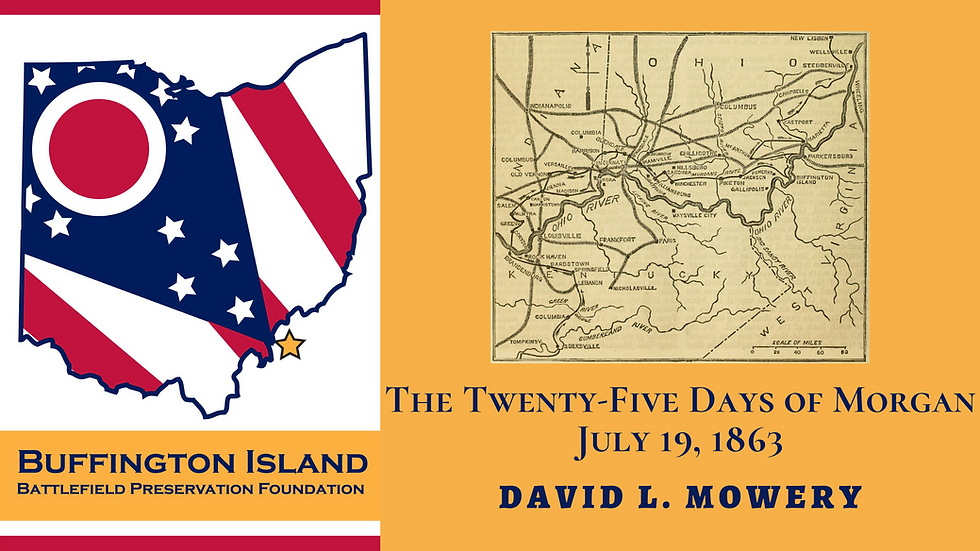The Federal Commanders at Buffington - Part II: August V. Kautz
- Darryl R. Smith

- Aug 15, 2022
- 3 min read
Updated: Apr 29
When one hears about the Buffington Island battle, we often hear about John H. Morgan and the Confederate point of view, but we rarely delve into the Federal leadership. This series of posts will talk about the various Union brigade and provisional division commanders in an effort to bring to light their stories. In the first post we presented Brigadier General Edward H. Hobson. This second installment is about Colonel August V. Kautz.

August Valentine Kautz was born in Baden (now part of Germany) on January 5, 1828. His parents would immigrate to the United States and settle in Brown County, Ohio in 1832. Kautz would serve in the Mexican-American war as a private in the First Regiment Ohio Volunteer Infantry. After this service he entered the United States Military Academy at West Point, graduating in the Class of 1852, the same class as fellow Ohioans George Crook and Alexander McCook, son of Daniel McCook who was mortally wounded at Buffington Island. Kautz would see service mostly in the Pacific Northwest after his graduation from West Point, being wounded twice while serving in the Fourth United States Infantry.
During the Civil War Kautz would serve in the Sixth United States Cavalry in the Peninsula campaign of 1862. Named as colonel of the Second Ohio Cavalry Regiment, Kautz would move to the Western Theater, and later be part of the Union force that would chase Morgan to Buffington Island. His command, a small brigade made up of two hundred selected men from the Second and Seventh Ohio Cavalry Regiments, would approach the battlefield along Bald Knob-Stiversville Road, and deploy in the area of the Middleswart Cemetery.[i]
After Buffington Island Kautz would serve under Ambrose Burnside‘s command in East Tennessee, then Kautz would return to the Eastern Theater as a brigadier general and lead cavalry operations around Richmond and Petersburg during 1864. In December of that year Kautz was nominated by Lincoln to the rank of brevet major general of volunteers, and Kautz would take over an infantry division of African-American troops and lead them into Richmond in early April, 1865. Kautz would then serve on the trial board that investigated the Lincoln assassination and in 1866 be nominated by President Andrew Johnson to the brevet rank of major general.
After the war Kautz would serve in the southwest including a stint as the commander of the Department of Arizona, then he returned to the Pacific Northwest as commander of the Department of the Columbia. He retired from the army in 1892 and passed away in Seattle in 1895. Kautz is buried in Arlington National Cemetery next to his wife and his brother Albert, who would serve in the United States Navy during the Civil War and later retire as a rear admiral. Another brother, Frederick, was a captain in the Fifty-Ninth Ohio Volunteer Infantry, and is credited with developing burley tobacco. Brothers John and George also served during the war. The Kautz men were also fast friends with Phillip Sheridan, Frederick naming one of his sons after Sheridan after the war. The Kautz home still stands along the Ohio River in southern Brown County.
For those wanting to know more about this interesting yet little-known personality can look into his biography, August Valentine Kautz: Biography of a Civil War General, written by the late Lawrence G. Kautz and published in 2015 by MacFarland & Company.
[i] The Second Ohio Cavalry was raised from men from Clermont, Columbiana, Geauga, Lorain, Mahoning, Medina, Summit, and Trumbull Counties. The Seventh Ohio Cavalry, known as the River Regiment, was raised from counties along the Ohio River (Hamilton, Clermont, Brown, Adams, Scioto, Lawrence, Gallia, Meigs, Washington, and Monroe. Lawrence and Monroe Counties failed to raise their contingents, so Gallia and Athens furnished the additional companies.)



Comments